Bring kayaks, bikes, beach toys and camping gear because Fort De Soto Park has it all
There are few parks in Florida with as much to offer as Pinellas County’s Fort DeSoto Park at the mouth of Tampa Bay.
And no public park in the state, not even Everglades National Park, draws as many visitors.
Consistently ranked as having the best beaches in Florida, the five islands of Fort DeSoto Park are wrapped in three miles of stunning white sand, drawing more than 2.7 million visitors every year.
Fort DeSoto Park attracts 2.7 million visitors a year, compared to 1.2 million visitors to Everglades National Park.
Anchored by the main island, Mullet Key, where the most popular beaches and the park’s namesake fort are found, Fort DeSoto sprawls across 1,100 acres and offers swimming, kayaking, camping, paved bicycle paths, a dog beach, picnic areas, playgrounds, shelling, a massive boat ramp and a history lesson or two.
NOTE: See our updated Florida Red Tide Report.
Fort Desoto Park is open every day from 7 a.m. until sunset, or you can camp here and have the run of the place all night. The sunsets from North Beach are truly something to behold.
Fort DeSoto has a $5 beach parking fee in addition to the Pinellas Bayway tolls you pay to get out to the park.
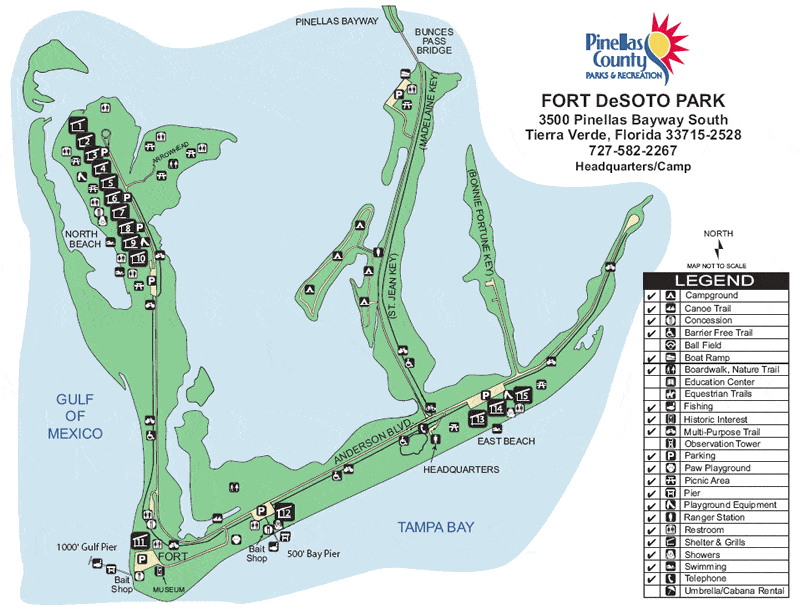
Fort De Soto’s North Beach: Most popular
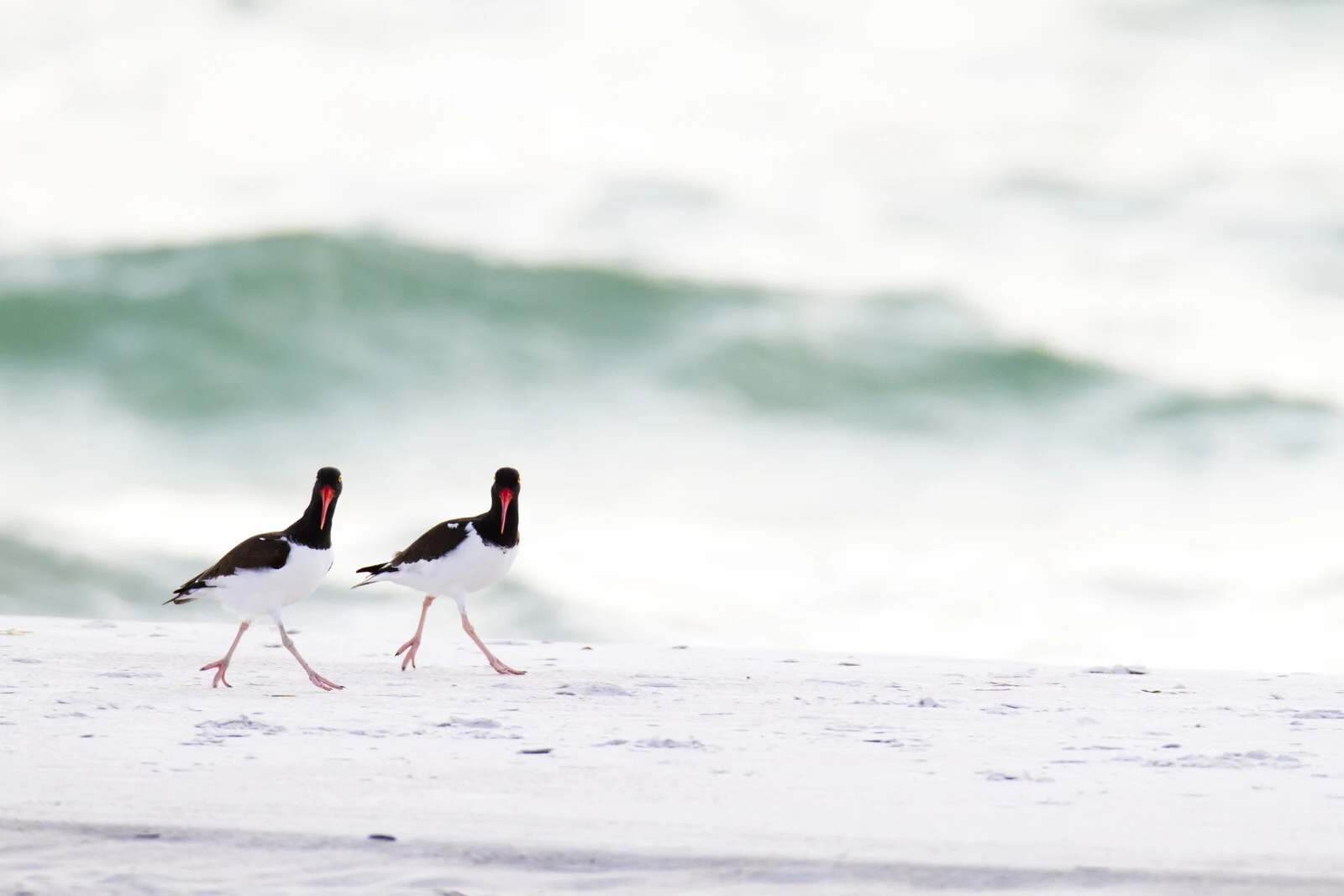
North Beach is probably the most popular, and this is the beach that gets all the praise.
With a massive parking lot to accommodate the crowds and 10 picnic shelters, it’s a magnet for beachgoers, and it can be difficult to find a secluded section of beach on weekends.
A section of North Beach is set aside as a sanctuary for shorebirds, off-limits to visitors, and the crowds tend to gravitate northward near the picnic shelters.
If you hike south of the sanctuary, back towards the pier, you are more likely to get away from the crowds.
The North Beach has four restrooms, including two near the parking area, a food concession and gift shop.
Beaches less visited at Fort De Soto Park
Gulf Pier Beach
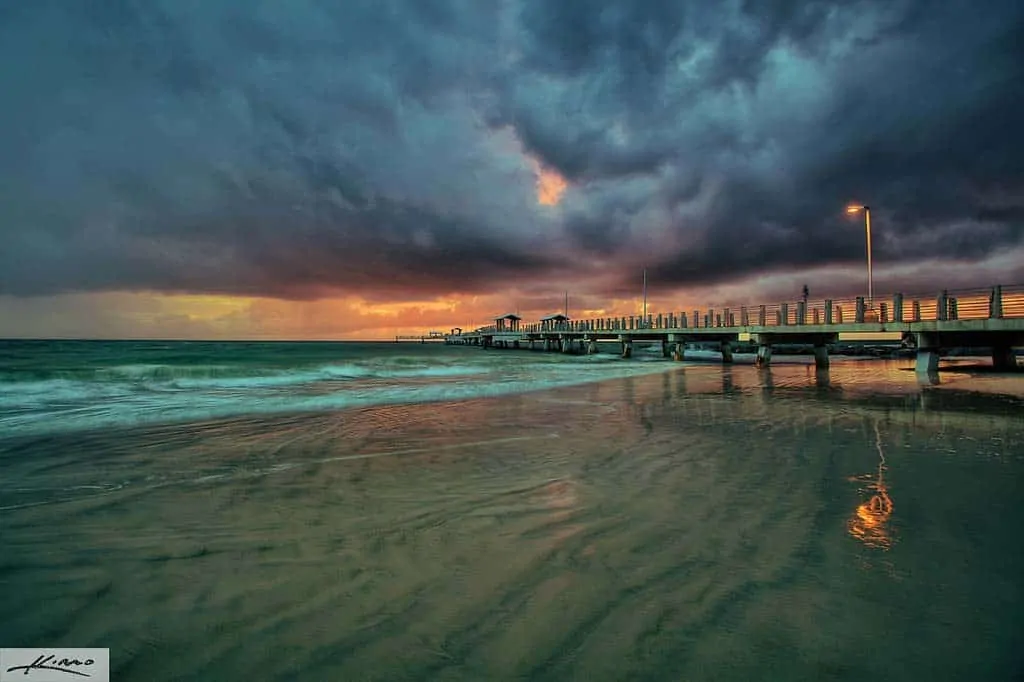
The beaches south of North Beach, closer to the Fort and the Gulf Pier, are considerably less crowded but harder to access.
Although there is parking at the fort and the pier, many a car can be found parked along the main road between the pier and North Beach with well-worn paths through the dunes.
The beach at the pier has a gift shop, food concession, rest rooms and a museum.
East Beach at Fort De Soto Park
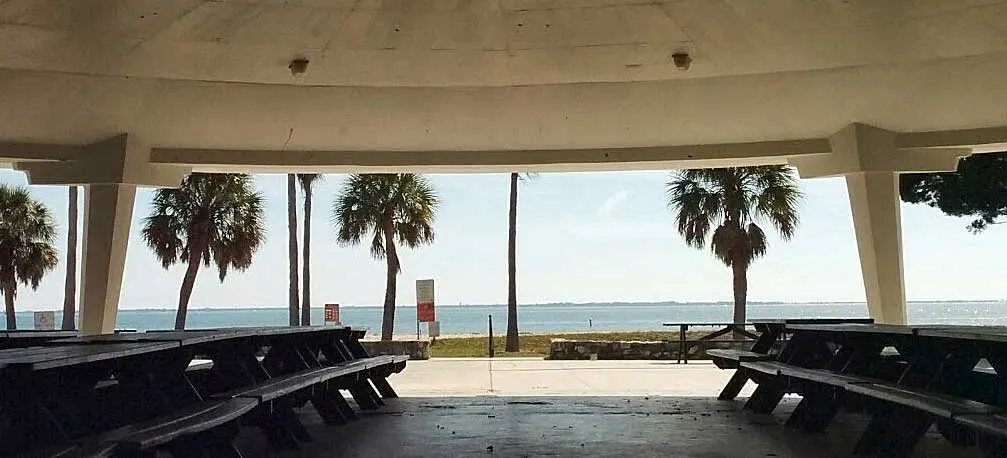
Another less-crowded option is the East Beach, unless there is a major event occupying its three huge pavilions.
Besides the picnic pavilions, the East Beach recreation area offers plenty of parking, a shady picnic area, and rest rooms, but the beach itself is a bit lackluster.
If you continue east past the beach park, you’ll drive out onto a point with a grassy beach where kite-boarders rule.
The nearest food concession for the East Beach is back at the Bay Pier, which also has a bait shop and its own beach access.
Dog Beach at Fort De Soto Park
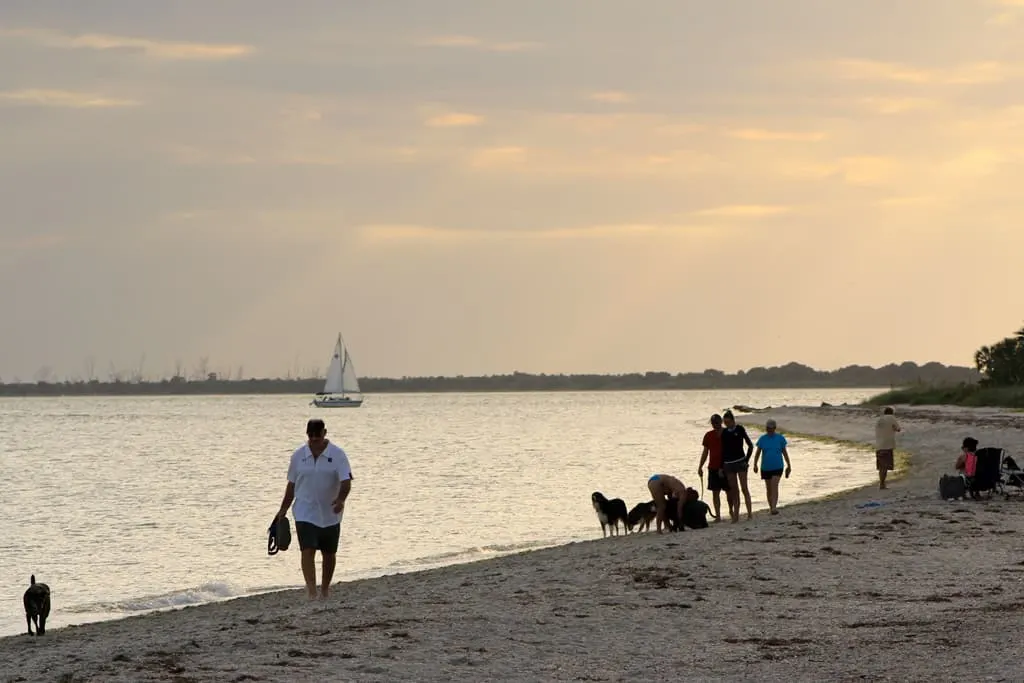
If you are bringing Fido to the beach, then the dog park near the Bay Pier is where you want to go.
The park has two fenced-in areas, one for large dogs and the other for small dogs, or you can let well-behaved pets loose to churn up some sand and swim in the bay.
Dog owners must have a leash handy but they are not required to be attached to your pet.
If you don’t like dogs, then this is not your beach. 🙂
Fishing at Fort De Soto Park
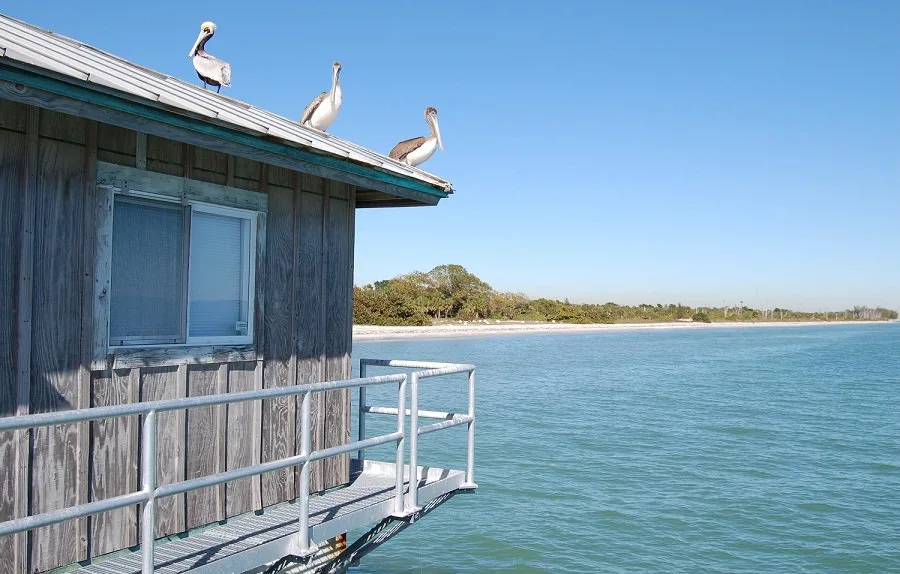
There are two fishing piers, the 1,000-foot Gulf Pier and the 500-foot Bay Pier.
Both have bait shops and food concessions, and both are in the path of fish flowing in and out of Tampa Bay.
The Gulf Pier has the stronger currents, so it’s likely you’ll find larger gamefish, even sharks, chasing mullet and other baitfish, while the calmer waters of the Bay Pier allow catches of Spanish mackerel, ladyfish, pompano, permit and the occasional tarpon.
Shore fishing is popular in the back bays and channels between the islands, where the catch may include spotted sea trout, snook and redfish.
Kayak anglers have a big advantage because they go right to the source, casting plugs into the roots of mangroves for snook, soft-bait jigs into the grass for spotted sea trout or around oyster bars for redfish.
Fishing License Required
A saltwater fishing license is required to fish anywhere in Fort De Soto Park, including the piers. A shore license, which is free for Florida residents, can be used on the piers, beaches and other shoreline.
A standard saltwater fishing license is required if you are fishing from a boat or kayak, unless you are 65 and under the age of 16. (You must have an ID to prove your age.)
There are exceptions for people with disabilities and active military.
For more information, visit the Florida Fish and Wildlife Commission web site.
Fort De Soto historic site

Imagine you are stationed at the mouth of Tampa Bay, aiming the cannons at the continuing line of schooners trying to supply the Confederate Army with supplies from Caribbean nations sympathetic to their cause.
Mullet Key had been a military outpost since the Civil War, when Union troops manned the island in an effort to block ships of the Confederacy from entering Tampa Bay.
But the fort itself wasn’t built until the Spanish American War. Uniquely, the fort was built out of shells and concrete because the rock intended for its construction did not arrive in time. It was completed and named after Spanish explorer Hernando De Soto in 1900.
All that remains of Fort DeSoto today is one of the two original mortar batteries with four of its guns still in place.
The fort was all but abandoned in 1910, although a caretaker force was in place until World War II, when it was used as a bombing range for nearby MacDill Air Force Base.
Pinellas County purchased the fort and surrounding islands in 1949, and it was established as a park in 1962.
Fort De Soto camping: Lots of sites but competition is stiff

This is not the easiest campground to book, despite its 236 campsites, at any time of year.
But it’s worth the effort. I manage to book a few days at Fort De Soto every year by watching for cancellations. Unless you’re online on the first day of availability, it’s unlikely you’ll get a site for the maximum 14 days, if at all.
Pinellas County residents get the first shot and are allowed to book sites up to seven months in advance. Non-county residents must wait another month, booking six months in advance.
The opportunities are better in the tent loop (Sites 1-85), where you can generally find a site on short notice.

The prime sites in the campground are in the RV loop, sites 165-236, on the north side of the outer island.
The tent sites, sites 1-85, are on the south end of the same island with the best sites (1-24) facing west on a grassy beach.
Pets are restricted to the second RV loop, sites 86-164, and about half of those sites are along seawalls. This is the loop where we usually are able to secure a reservation, if only for a few days. (See the photo above.)
The campground has a kayak concession and a small store, but campers looking for groceries will have to go back to Tierra Verde, where there are a couple of convenience stores, or the Publix on the Bayway.
Kayaking at Fort De Soto Park
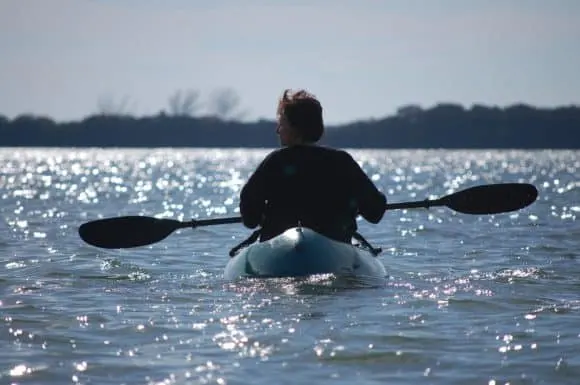
The beauty of the Fort De Soto Park campground is the preponderance of waterfront sites where you can launch a kayak directly from your site.
Day visitors can launch from the boat ramp near the park entrance, at Soldiers Hole across the park road from Dog Beach, or anywhere you can find access to water from the swale along park roads.
Kayak and canoe rentals are available in the campground, near the park office, and at Soldiers Hole, across from Dog Beach.
On a calm day, you can paddle out into Tampa Bay or out to the pristine beaches of Shell Key on the Gulf side. Shell Key is part of a preserve, which can also be reached by ferry from the park boat ramp.
Shell Key: Pristine island complements Fort De Soto Park
Shell Key is an uninhabited barrier island that is part of a preserve north of De Soto’s North Beach accessible only by water.
This pristine island is a sheller’s paradise and may be crowded on weekends.
Overnight primitive camping is allowed but a permit is required. The permit costs is $6 per day per group of up to six people.
The camping permit does not cover the boat ramp fee. The ramp is the closest launch point.
If you don’t have your own boat, you can arrange transportation aboard the Shell Key Ferry, which also departs from the boat ramp.
Go to Egmont Key from Fort De Soto Park
Egmont Key is a wild island that figured into two centuries of Florida history — from a lighthouse built in 1858 to a role in the Spanish American War to being the site where Seminole Indians were held before they were moved to reservations.
The stunning island, encircled by beaches, is a state park and wildlife refuge across the mouth of Tampa Bay, accessible only by boat.
The ruins of the 18th century Fort Dade, which once had 300 inhabitants, are scattered around the island.
Nearly half the island is closed to visitors as a wildlife reserve, but you’ll still find six miles of trails for hiking. The island is also a popular snorkeling and swimming destination.
The Egmont Key Ferry runs daily at 10 a.m. and 11 a.m. from Fort De Soto’s Bay Pier. Passengers are given three hours to explore and enjoy the island. A third ferry is offered on Tuesdays, Thursdays, Saturdays and Sundays at 2 p.m.
Read More: Egmont Key: 5 things I love about it
Fort De Soto’s bike path
Fort De Soto features a seven-mile-long paved bike path that runs from the park entrance to all points in the park, including the campground, the beaches and the fishing piers.
The trail parallels park roadways but is separated from vehicle traffic, making it family-safe.
Bicycle rentals are available in the park and at the campground concession.
Linking to the popular Pinellas Trail
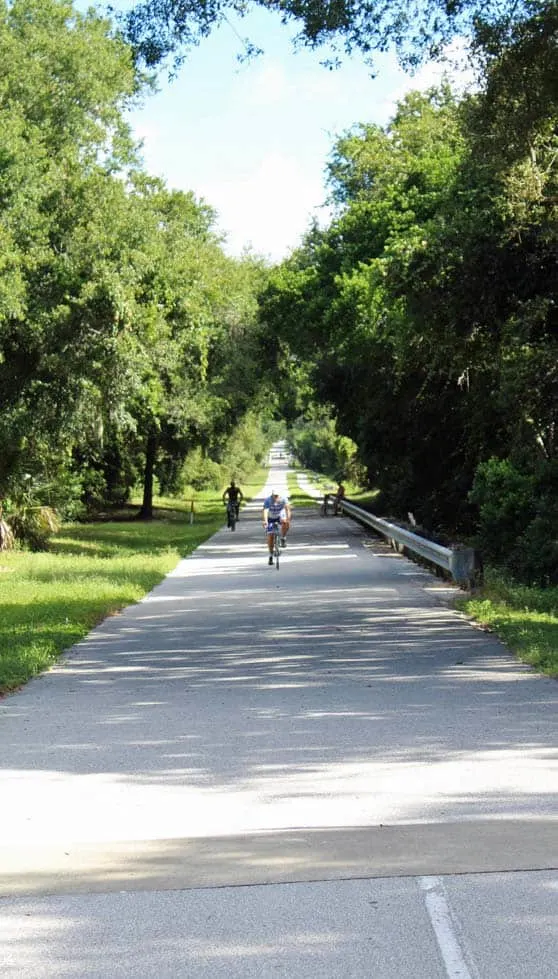
The Pinellas Trail is a beautiful multi-purpose trail built on an abandoned railroad bed through the middle of the peninsula, and while there is no direct link (yet) from Fort De Soto, it would be a natural connection.
Until then, there is a paved bike trail that runs five miles from the park entrance through Tierra Verde to the Pinellas Bayway, connecting to another paved trail alongside the Bayway.
If you turn right on the Bayway bike path, you can reach the Pinellas Trail by heading east to 34th Street South. Cross the street at the light and double back to 37th Street South behind the CVS. That’s the start of the northbound Pinellas Trail, leading to either downtown St. Petersburg or all the way north to Tarpon Springs.
The Pinellas Trail is an adventure of its own, taking riders through residential neighborhoods and multiple downtowns.
Read more: Treasured bike trail in St. Pete
Planning a visit to Fort De Soto Park
Fort De Soto Park, 3500 Pinellas Bayway S.,Tierra Verde Phone: (727) 582-2267
What’s near Fort DeSoto Park?
Egmont Key: 5 things I love about it
Arts & Brew walk: Explore St. Petersburg brewpubs and galleries
Pass-a-Grille, one of Florida’s best beaches in a charming historic town
Best camping near Tampa Bay: 9 choice campgrounds
Dunedin: Delightful biking, breweries, beaches & more
Safety Harbor Spa: Healing waters are star of charming town
Hillsborough River State Park adds ‘glam’ to its camping options

Bob Rountree is a beach bum, angler and camper who has explored Florida for decades. No adventure is complete without a scenic paddle trail or unpaved road to nowhere. Bob co-founded FloridaRambler.com with fellow journalist Bonnie Gross 14 years ago.

carlton O phelps
Wednesday 13th of January 2021
When my life time partner and were dating, we been married 50 years, Ft Desoto is one of the first beaches I took her to. I use to visit the beaches there with my family before that. Beautiful clear water, then, great beaches, still, plenty of restrooms, more now, historical and good fishing. I haven't gone kayaking yet but after my knee replacement, 1-26-21, I will be heading back. By the way we live a little over 60 miles away.
Dale Hamblin
Wednesday 13th of January 2021
Dear Robert: We have read before on this from younor Bonnie. We were there in 2019 but stayed at the lighthouse south so missed boat. We will be back October 27-28, staying at Historic Bradenton Hampton Inn( my hotel ) and will be making the trip out to the Island! If you could make restaurant recommendations anywhere In the area that would be great! We are staying at Disney, 25-26, Hilton 29, Cabins, 30,31,1,2,3 November. We then are flying into Miami December 6,7 in Florida City( Hilton) and Key Largo( Hilton, 8-9-10, returning to Deering Estate on 11th for a boat ride( In 2019 our boat made it out for 1/2 hour when it was to rough so we had to come back) Any idea on places to eat lower keys by Key Largo would be helpful! Bfast, Lunch and Dinner! All your Rambler info has been great for us! Thank You, Dale L Hamblin